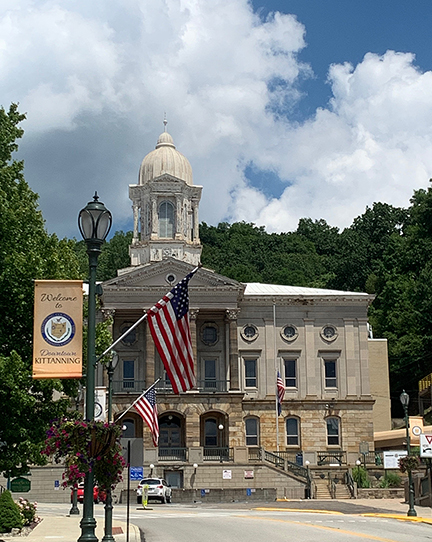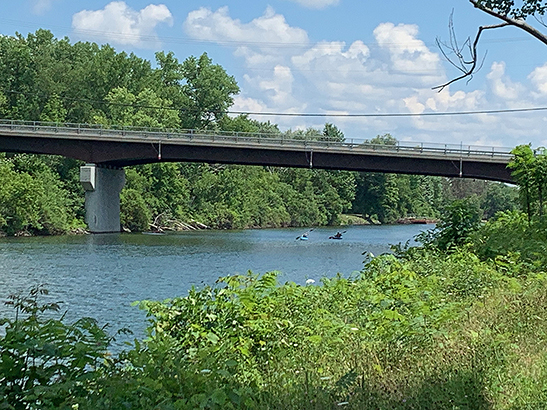Our four nights/three days at Huntington Beach were full of long hikes and longer bike rides. We had hoped to get to Brookgreen Gardens, the United States’ first sculpture garden (founded by Archer Huntington and his wife, Anna Hyatt Huntington) to showcase her sculpture collection. The property, created from four defunct rice plantations, comprises 9,100 acres with several themed gardens, the Lowcountry Zoo, and trails through several ecosystems.
At the time we were there, however, they were doing a holiday light show in the sculpture garden, and the tickets to see it were hard to come by as well as being expensive. So we were unable to get into any aspect of the property, even though the gates shared a visitor center and parking lot with the State Park.
For those interested in history, there’s a description of the evolution of Brookgreen Gardens at the end of this post.
Of course, seafood remained on the agenda, and since none of us were comfortable eating at a restaurant, we contented ourselves with purchasing fresh seafood and “eating in.”
Some good trails wound through the woodsy areas around the park, and there was a lot of beach access within walking distance. The weather turned windy and chill, but that didn’t stop us from long hikes and bike rides around the grounds.

On the 31st, I went to the beach and caught a pelican ballet above the choppy surf.
Jack and I took several long bike rides through and around the park, as well as some urban riding around Murrells Inlet, the burgh near the park. On one of the cooler days, we rode our bikes out to a harbor restaurant associated with the Dead Dog Saloon called Wicked Tuna in Murrells Inlet. John and Mary drove over in their van and we had lunch there, eating our meal in the quite cool breezes off the harbor in the “closed” deck of the restaurant out back. We had fun people-watching, but were the only ones back there and had a variety of seafood meals amongst us. The staff was quite accommodating of our need for isolation. It was good food—Jack and I split a huge order of lobster rolls—and Jack had a slice of cheesecake at the end that powered his ride back to camp as the wind blew up the threat of rain. He set a blistering pace, and we made it without getting wet.
One night, we tried out my tripod for cooking with a Dutch Oven over a fire or coals for the first time. Chili was in the pot, and we nearly couldn’t get the pot high enough over the solo stove to keep everything from boiling over, but John and Jack managed it a some length. Next time we’ll wait until the fire has calmed and the coals are what heats the pot.

I took the doggies on several of my long treks out and about. It wind was howling on the beach proper for the most part, but I did discover this “beach art” one one walk:
On another hike, I took a “nature loop” back through the woods to a preserve area called the Sandpiper Pond and saw this really neat tree:

Of course, the dogs loved the walks, even though they much prefer the freedom of romping around our home acreage without restraint.

Our next stop was a one-nighter as a quick layover en route to one of our fave “hometown” campgrounds, North Bend, near Boydton, VA. But to ease the distance between Huntington Beach and North Bend, we stopped for New Year’s Day night at Cliffs of the Neuse State Park in North Carolina, near Seven Springs.
We’d never been before and weren’t there long, but intend to go back and spend more time. It’s small and intimate, with a good diversity of hiking trails, and we’d like to know more. Our site was #8, electric only, and the day was overcast, leaving the Neuse River foggy and mysterious.

Our final stop of this adventure was at North Bend, on J. H. Kerr Lake, which actually had lots and lots of shoreline and camping options on both sides of the VA/NC border. We habitually stay at North Bend campground because they leave a couple of small loops open year-round, and while they shut off water at the sites, they leave open (and warmed and regularly cleaned) a bath house for campers to use. All the winter-available sites are “walk-up” and we ended up choosing #84 this time. Not a water site, but we enjoyed some spectacular sunsets through the trees at our “back yard.”

One of the sunsets we enjoyed reflected in such a way as to metaphorically “set the woods afire.” The light had an interesting effect on our Clam screen house, too:

As is usual for us, we took down the bikes and toured the open and closed loops, boat ramps, picnic areas—basically all the paved roadways—to accumulate 10-12 miles of cycling with zero traffic. The doggies and I walked a whole bunch also, and enjoyed winter-ish sunsets and vistas over the water.
As we also habitually do, we rode our bikes down below the dam to watch the bald eagles and osprey. There was quite a lot of activity at that end of the lake the two times we went down there to watch, with young eagles and osprey both sparring in the air for territory—both perching limbs and fishing options.

While unable to get any photos of the eagle/osprey contests, I did get a shot of this perched great blue heron:

On our final night, we cooked dinner outside, off the back of the truck using the topper light. The Solo stove fire was lit and we enjoyed the end of our winter 2020-2021 adventure doing our favorite things we love about camping: eating well and sitting around a campfire watching the coals. The only things missing were friends with whom to share it.

Slàinte.
Brookgreen Gardens
Founded by Archer Milton Huntington (stepson of railroad magnate Collis Potter Huntington) and his wife, Anna Hyatt Huntington Brookgreen Gardens features sculptures by Anna and her sister Harriet Randolph Hyatt Mayor, along with other American sculptors. Brookgreen Gardens opened in 1932 having been developed on property of four former rice plantations. It took its name from the former Brookgreen plantation, which dates to the antebellum period.
Development began with the purchase in January 1930 as a site for a winter home as well as a setting for Mrs. Huntington’s sculpture work. Construction of the house, named Atalaya, a Spanish term for “watchtower,” began the following winter of 1931 (Archer Huntington was a noted authority on Spanish culture, and he designed the house after the Moorish architecture of the Spanish Mediterranean Coast).
Workers alternated between construction on Atalaya and Brookgreen Gardens over a two- to three-year period. Mr. Huntington insisted that local labor be employed in its construction to provide work opportunities during the Great Depression.
The outer walls of the building form a square, with the east side facing the ocean. Within the walled structure, there are two grassy open inner courtyards with a main entry court on the west side. The living quarters consist of 30 rooms around three sides of the perimeter. The one-story brick building is dominated by a square tower that rises nearly 40 feet from a covered walkway and bisects the inner court. It is functional in design, having once contained a 3,000 gallon cypress water tank. Water drawn from an artesian well was then pumped into a 10,000 gallon concrete cistern where the sand settled. From there, it was pumped into the tower tank. The height of this tank gave the water enough pressure to flow through the house.
The covered walkway of open brickwork is lined with archways and planters on both sides. Living facilities, including the dining room, sunroom, library, and bedrooms, occupied the ocean-facing side of the house. The southern wing housed Mr. Huntington’s spacious study, his secretary’s office, and Mrs. Huntington’s studio.
The studio, with a 25-ft skylight, opened onto a wall enclosed courtyard where Mrs, Huntington worked on her sculptures. Due to her passion for sculpting animals, she had facilities such as horse stables, a dog kennel, and a bear pen included in the construction. The Huntingtons resided in the house during the colder months of the year, usually from November until March or April.
Heating was entirely by coal room heaters and wood-burning fireplaces. Ramps led from the courtyards up to each entry door, and wood was hauled in using small carts. Grillwork—designed by Mrs. Huntington—and shutters were installed on each window to protect against hurricane-force winds.
After Mr. Huntigton’s death in 1955, most of the furnishings from the house were sent to the Huntington home in NYC. The 2,500-acre tract, including Atalaya, was leased to the state by the Brookgreen Trustees in 1960. Mrs. Huntington died at her Connecticut home in 1973. In tribute to Mrs. Huntington, the annual Atalaya Arts and Crafts Festival is held in the Castle during the fourth weekend of September.







































































































































































































































